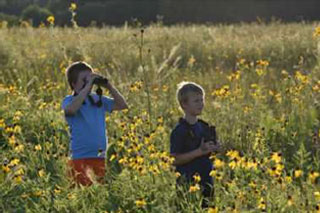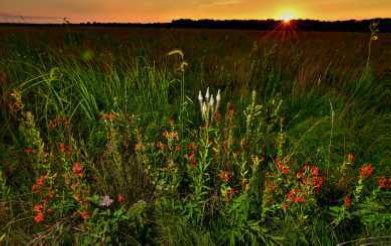Improving and expanding grasslands will increase populations of:
- Northern bobwhite.
- Henslow’s sparrows.
- Loggerhead shrike.
- Ring-necked pheasants.
- Other grassland species.

How GGS works
GGS is a partnership with other conservation agencies including DNR, USDA Natural Resources Conservation Service, Natural Resources Foundation, non-profit conservation groups, private industries and other sponsors to:
- Develop and improve grasslands and pollinator habitats in targeted areas in Indiana.
- Improve soil health and water quality.
- Improve species diversity.
- Increase hunting, birding and outdoor recreation opportunities.
- Improve overall human health.
- Increase funding to local economies.
- Preserve cultural heritage.
Grasslands for Gamebirds & Songbirds (GGS) program biologists can visit your property and provide technical assistance about how to better manage your property for grassland and pollinator species.

Whether your interest is helping pollinators, wildlife viewing, gamebird hunting, or conservation-minded land management, GGS can benefit you as a landowner. Grassland Biologists can create a customized plan to help you manage your property to maximize benefits to wildlife and the environment.
Voluntary opportunity for additional financial incentives
There is also potential to expand opportunities for recreation and landowner assistance through the Indiana Private Lands Access Program (IPLA – formerly known as APPLE). This program offers additional financial incentives to landowners who allow controlled public access hunting on their private lands. GGS participants may be eligible but are not required to participate in IPLA.
Eligible GGS areas
GGS targets four key areas of the state known as focal regions. These regions have been selected based on such factors as existing quail or ring-necked pheasant habitat and potential for habitat establishment and connectivity throughout a region. Data and guidance from the National Bobwhite Conservation Initiative and the National Wild Pheasant Conservation Plan was also used to identify focal regions, which are listed below.
- Northwest – Newton, Jasper, Starke, Pulaski, White, Benton, Warren.
- Northeast – LaGrange, Noble, Steuben, Dekalb, Kosciusko, Whitley, Blackford, Jay.
- Southeast – Jackson, Jennings, Ripley, Dearborn, Jefferson, Scott, Washington, Clark, Floyd, Harrison, Lawrence, Orange.
- Southwest – Putnam, Clay, Sullivan, Greene, Knox, Daviess, Gibson, Pike, Warrick, Spencer, Vermillion, Parke, Montgomery.
How to join
Contact:
- Nate Yazel, Southeast Grassland Biologist, 812-718-4117. nyazel@dnr.IN.gov
- Adam Delucenay, North Grassland Biologist, 260-788-0336, adelucenay@dnr.IN.gov
How to help
To make the program a success, you can help by donating $5 to $50,000 or more to create quality grassland and pollinator habitats. Your donation helps fund the GGS program directly since all donations are used as matching funds to leverage additional monies.
How to donate
Donations are tax-deductible.
Please mail check or money order, made payable to The Division of Fish & Wildlife. Denote GGS in the memo for proper routing. Address:
Grasslands for Gamebirds & Songbirds
2650 State Road 44
Martinsville, IN 46151
For more information contact Josh Griffin at jgriffin@dnr.IN.gov or 765-792-4873



